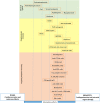Hypertension: a new treatment for an old disease? Targeting the immune system
- PMID: 29969833
- PMCID: PMC6534786
- DOI: 10.1111/bph.14436
Hypertension: a new treatment for an old disease? Targeting the immune system
Abstract
Arterial hypertension represents a serious public health problem, being a major cause of morbidity and mortality worldwide. The availability of many antihypertensive therapeutic strategies still fails to adequately treat around 20% of hypertensive patients, who are considered resistant to conventional treatment. In the pathogenesis of hypertension, immune system mechanisms are activated and both the innate and adaptive immune responses play a crucial role. However, what, when and how the immune system is triggered during hypertension development is still largely undefined. In this context, this review highlights scientific advances in the manipulation of the immune system in order to attenuate hypertension and end-organ damage. Here, we discuss the potential use of immunosuppressants and immunomodulators as pharmacological tools to control the activation of the immune system, by non-specific and specific mechanisms, to treat hypertension and improve end-organ damage. Nevertheless, more clinical trials should be performed with these drugs to establish their therapeutic efficacy, safety and risk-benefit ratio in hypertensive conditions. LINKED ARTICLES: This article is part of a themed section on Immune Targets in Hypertension. To view the other articles in this section visit http://onlinelibrary.wiley.com/doi/10.1111/bph.v176.12/issuetoc.
© 2018 The British Pharmacological Society.
Conflict of interest statement
The authors declare no conflicts of interest.
Figures


Similar articles
-
Monocytes as immune targets in arterial hypertension.Br J Pharmacol. 2019 Jun;176(12):1966-1977. doi: 10.1111/bph.14389. Epub 2018 Jul 14. Br J Pharmacol. 2019. PMID: 29885051 Free PMC article. Review.
-
Targeting toll-like receptor 4 signalling pathways: can therapeutics pay the toll for hypertension?Br J Pharmacol. 2019 Jun;176(12):1864-1879. doi: 10.1111/bph.14438. Epub 2018 Aug 9. Br J Pharmacol. 2019. PMID: 29981161 Free PMC article. Review.
-
Role of immune cells in hypertension.Br J Pharmacol. 2019 Jun;176(12):1818-1828. doi: 10.1111/bph.14427. Epub 2018 Jul 20. Br J Pharmacol. 2019. PMID: 29952002 Free PMC article. Review.
-
Human monocyte transcriptional profiling identifies IL-18 receptor accessory protein and lactoferrin as novel immune targets in hypertension.Br J Pharmacol. 2019 Jun;176(12):2015-2027. doi: 10.1111/bph.14364. Epub 2018 Jun 21. Br J Pharmacol. 2019. PMID: 29774543 Free PMC article.
-
Immune cell trafficking, lymphatics and hypertension.Br J Pharmacol. 2019 Jun;176(12):1978-1988. doi: 10.1111/bph.14370. Epub 2018 Jun 25. Br J Pharmacol. 2019. PMID: 29797446 Free PMC article. Review.
Cited by
-
Immunity and hypertension: New targets to lighten the pressure.Br J Pharmacol. 2019 Jun;176(12):1813-1817. doi: 10.1111/bph.14659. Br J Pharmacol. 2019. PMID: 31127619 Free PMC article.
-
CARD9 Regulation and its Role in Cardiovascular Diseases.Int J Biol Sci. 2022 Jan 1;18(3):970-982. doi: 10.7150/ijbs.65979. eCollection 2022. Int J Biol Sci. 2022. PMID: 35173530 Free PMC article. Review.
-
Chemoattraction and Recruitment of Activated Immune Cells, Central Autonomic Control, and Blood Pressure Regulation.Front Physiol. 2019 Aug 2;10:984. doi: 10.3389/fphys.2019.00984. eCollection 2019. Front Physiol. 2019. PMID: 31427987 Free PMC article. Review.
-
O-Linked β-N-Acetylglucosamine Modification: Linking Hypertension and the Immune System.Front Immunol. 2022 Mar 17;13:852115. doi: 10.3389/fimmu.2022.852115. eCollection 2022. Front Immunol. 2022. PMID: 35371030 Free PMC article. Review.
-
Standard Doses of Cholecalciferol Reduce Glucose and Increase Glutamine in Obesity-Related Hypertension: Results of a Randomized Trial.Int J Mol Sci. 2024 Mar 18;25(6):3416. doi: 10.3390/ijms25063416. Int J Mol Sci. 2024. PMID: 38542390 Free PMC article. Clinical Trial.
References
-
- Abbate A, Van Tassell BW, Biondi‐Zoccai G, Kontos MC, Grizzard JD, Spillman DW et al (2013). Effects of interleukin‐1 blockade with anakinra on adverse cardiac remodeling and heart failure after acute myocardial infarction [from the Virginia Commonwealth University – Anakinra Remodeling Trial (2) (VCU‐ART2) pilot study]. Am J Cardiol 111: 1394–1400. - PMC - PubMed
-
- Ahn KO, Lim SW, Li C, Yang HJ, Ghee JY, Kim JY et al (2007). Influence of angiotensin II on expression of toll‐like receptor 2 and maturation of dendritic cells in chronic cyclosporine nephropathy. Transplantation 83: 938–947. - PubMed
-
- Albuquerque D, Nihei J, Cardillo F, Singh R (2010). The ACE inhibitors enalapril and captopril modulate cytokine responses in Balb/c and C57Bl/6 normal mice and increase CD4+CD103+CD25negative splenic T cell numbers. Cell Immunol 260: 92–97. - PubMed
Publication types
MeSH terms
Substances
LinkOut - more resources
Full Text Sources
Other Literature Sources
Medical

